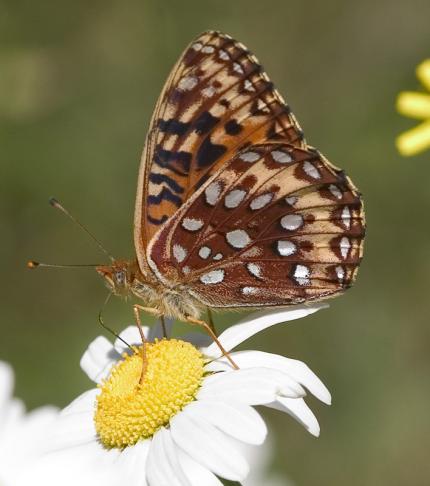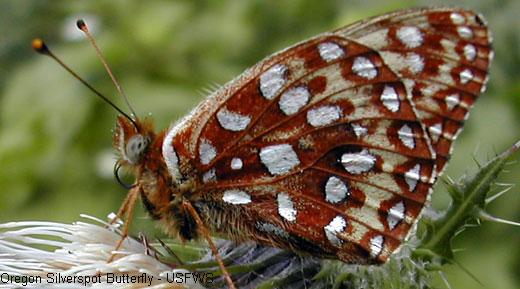Moderate
The Oregon silverspot butterfly is likely extirpated in Washington and will require reintroduction from captive reared or wild populations in Oregon. The butterfly is recognized as a "Species of Greatest Conservation Need" in Washington due to their rare and restricted hostplants and habitat types, small number of isolated populations, limited range and distribution, and known threats to their habitats.
Description and Range
Physical description
The Oregon silverspot butterfly is in the Heliconiinae (Fritillary) subfamily, which consists of medium and large sized butterflies with distinctive black line and dot patterning on bright orange dorsally, and a heavily-patterned ventrum with silvery orbs (genus Argynnis : greater fritillaries) or muted colored triangles (genus Boloria: lesser fritillaries). The Oregon silverspot is part of the greater fritillaries (genus Argynnis ) that complete a single life cycle annually (univoltine)
Ecology and life history
Like other fritillaries, Oregon silverspot butterfly are sedentary butterflies and do not migrate; instead, the species inhabits sites year-round (as egg, larva, pupa and adult). The Oregon silverspot butterfly uses open, short-stature grasslands in coastal dunes, bluffs, and nearby forest glades. Habitat studies have been conducted for this butterfly on the remaining sites in Oregon; early blue violet is the sole hostplant for this butterfly, and females selected patches with more than 20 plants per square yard for egg-laying sites. Although the Oregon silverspot butterfly has been extirpated from Washington, WDFW has led habitat restoration efforts on coastal sites in Pacific County in preparation for future butterfly reintroductions.

Both males and females feed by using their long proboscis to sip floral nectar. Research on other Speyeria spp. suggests that nectar availability affects the number of eggs laid by females.
Adults emerge from their chrysalids (pupae) during species-specific time periods; typically early-to-late summer for Argynnis. Males begin emergence first, followed by females; late season individuals are primarily or solely females. Weather influences butterfly emergence and flight period duration, with wet or cold conditions potentially delaying emergence.
Male fritillaries seek mates using rapid patrolling and searching flight behavior. Females search for egg-laying sites by slowly flying and hovering above hostplants and then landing and crawling to inspect vegetation before depositing eggs singly.
These species depend on violets (genus Viola) for their hostplants. Argynnis fritillaries lay eggs late in the summer. A tiny larva hatches within a few weeks and seeks shelter to overwinter, but does not feed until the following spring.
Fritillary larvae are generally dark with many bristled spines, and feed nocturnally; these characteristics, along with a gland that secretes defensive chemicals, protect larvae from predators.
Geographic range
The Oregon silverspot butterfly is thought to be extirpated from Washington; however, habitat has been restored and plans have been made to reintroduce this species in Pacific County. In Washington, historically the Oregon silverspot butterfly inhabited sites along the coast from Westport to the Columbia River. A population persisted in Washington on the Long Beach Peninsula through at least 1985, when intensive searches revealed a few butterflies remaining. The most recent surveys in Washington, in 1991 and 1996 found no Oregon silverspot butterflies, and in 1996 no suitable habitat.
Today, all but 5 localities (one in California and 4 in Oregon) of this butterfly have been extirpated. The current overall range of this species is coastal Oregon and northern California.
For a map of range-wide distribution and conservation status of this species, check out NatureServe Explorer.
Climate vulnerability
Sensitivity to climate change
Moderate
Oregon silverspot exhibits some physiological sensitivity to temperature and precipitation, as larval development, pupation, and adult emergence timing vary each year according to weather, and adults exhibit thermoregulatory behavior during cold, windy conditions (e.g., shelter in warmer adjacent forest edges). Warmer temperatures may increase adult activity (i.e., require less basking time) and/or accelerate larval development. Oregon silverspot is also sensitive to climate-driven changes in habitat availability and quality. Increasing fire frequencies may help maintain the low stature coastal grassland this species requires and help prevent succession to forest or shrub ecotypes. Increasing fire frequency will likely also facilitate reproduction and germination of early blue violet, the larval host plant for Oregon silverspot. Early blue violet is a shade-intolerant species that reproduces and germinates best in early successional coastal grasslands with bare soil or low, sparse grass cover. Early blue violet is also tolerant of hot, dry periods, which will help maintain long-term Oregon silverspot habitat areas under a warmer, drier climatic regime. However, dry years may cause early senescence of early blue violets, which can cause larval mortality.
Exposure to climate change
Moderate
- Increased temperatures
- Drought
Conservation
Conservation Threats and Actions Needed
- Invasive and other problematic species
- Threat: Invasive plants, those currently here, and many yet to come in the future, out-compete native grassland species, and otherwise make habitat unsuitable for the Oregon silverspot butterfly.
- Actions Needed: Using herbicide, fire, and mechanical methods to restore native prairie; planting/seeding native prairie species.
- Fish and wildlife habitat loss or degradation
- Threat: No population currently extant (still in existence) in Washington.
- Action Needed: Reintroduce at restored sites.
See the Climate vulnerability section above for information about threats posed to the Oregon silverspot butterfly by climate change.
Resources
References
Boggs, C. 2003. Environmental variation, life histories, and allocation in Butterflies: Ecology and Evolution Taking Flight. Boggs, C., W. Watt, and P. Ehrlich, eds. The University of Chicago Press. 737pp.
James, D. and D. Nunnallee. 2011. Life Histories of Cascadia Butterflies. Oregon State Univ. Press, Corvallis. 447pp.
Pyle, R.M. and LaBar, C.C. 2018. Butterflies of the Pacific Northwest. Timber Press. 461 pp.
Pyle, R. 1989. Washington butterfly conservation status report and plan. WDFW, Olympia. 216pp.
Schultz, C., E. Henry, A. Carleton, T. Hicks, R. Thomas, A. Potter, M. Collins, M. Linders, C. Fimbel, S. Black, H. Anderson, G. Diehl, S. Hamman, R. Gilbert, J. Foster, D. Hays, D. Wilderman, R. Davenport, E. Steel, N. Page, P. Lilley, J. Heron, N. Kroeker, C. Webb, and B. Reader. 2011. Conservation of prairie-oak butterflies in Oregon, Washington, and British Columbia. Northwest Science 85: 361–388.
Zhang, J., Q. Cong, J. Shen, P. A. Opler and N. V. Grishin. 2020. Genomic evidence suggests further changes of butterfly names. The Taxonomic Report of The International Lepidoptera Survey 8(7):1-41.
